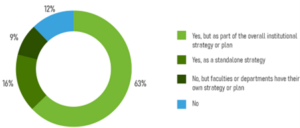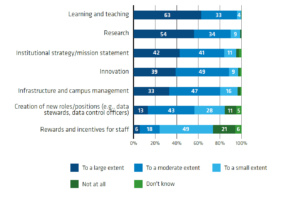
Accelerated technological and societal developments are putting universities under pressure to innovate much faster and have impacted universities’ visions and strategies. Vision and strategy are inextricably linked when it comes to the digital transformation of European higher education. A strategy cannot be developed without a focused vision, and a vision cannot be realised without a robust strategy and implementation plan.
Vision
Having a strategic and focused vision of what higher education institutions want to achieve from the digital transformation is crucial. University leaders need to ask themselves why digitalisation is important for the institution and where it fits in the institution‘s vision, as put forward by EUA’s Thematic Peer Group report, ‘Strategy and Organisational Culture’.
There is a broad consensus among university leadership that such a strategic vision needs to be applicable to all university functions – learning and teaching, research, knowledge transfer as well as the administration of the university as a whole. EUA’s survey on universities and innovation has revealed that, at present, the digital transformation at universities is implemented primarily in learning and teaching and research activities. In the future, the vision and strategies of institutions should also explicitly integrate digital transformation into universities’ innovation mission.
The digital transformation of universities is best guided by a clear vision. Institutions’ visions for transformation are typically aligned in that they are rooted in values shared across society and the sector such as inclusivity, transparency, accessibility and openness. The specific actions pursued can depend on priorities on the national agenda and the interests of individual university leaders. The leadership of an institution can have a vision of a more efficiently run university and focus on administrative procedures. Others will look to the student experience, possibly with a focus on access to higher education and student retention, and here learning analytics and data-driven governance could be instruments for the purpose of enhancing the student experience. Several institutions have a vision of a digitally sovereign university, making choices driven by the wish to retain control over software and data.
Strategy
To realise this vision, a clear strategy and set objectives are needed as well as clarity on who will manage and govern the strategy. Moreover, the importance of a clear university strategy has increased in light of a greater focus on accountability, transparency and governance in higher education.
Prior to the pandemic, almost 90% of institutions had a strategy for the digitalisation of learning and teaching, which tended to be managed at a central level or between central-level and faculty-based units. When it comes to visions that include Open Science, 57% of institutions surveyed between 2020 and 2021 had strategies, and 37% said that they were in the process of developing one. The pandemic increased the awareness of the importance of Open Science, at both institutional and national levels. However, during the pandemic, the focus moved away from policy development and shifted toward fast improvement of institutional practice, which now needs to be anchored strategically.

Figure 1 Survey on digitally enhanced learning and teaching in European higher education institutions (2021): Q7: Does your institution have a strategy for the digitalisation of learning and teaching? N=360
EUA’s survey on digitally enhanced learning and teaching in European higher education institutions showed that strategies for the digitalisation of learning and teaching were generally part of the overall institutional strategy or plan, with a minority being standalone strategies focussing solely on the digitalisation of learning and teaching.
Institutional strategies and mission statements feature among the key areas for the implementation of the digital transition at institutional level, according to the EUA Innovation survey report published in 2022.

Figure 2: Universities as key drivers of sustainable innovation ecosystems. Results of the EUA survey on universities and innovation. Q22. In which areas is your institution implementing the digital transition? Number of respondents: 154-163/166
Strategies and focal points
In the fast-changing world in the wake of digital transformation, a successful university strategy needs to indicate room for development and a direction for the future, as well as, increasingly, also providing a sense of stability and an appreciation of the institution’s heritage. A clear university strategy has its roots in the institution’s specific culture, makes its intangible aspects explicit and builds on it for the future, thus developing the USPs that set the institution apart in an increasingly competitive environment.
When it comes to strategy development, a question is whether institutions wish to develop a standalone or embedded strategy. On the one hand, institutions have the choice to develop a separate strategy for digital transformation. On the other hand, the role of digitalisation could be embedded within existing plans such as the institution’s learning and teaching, internationalisation, or open science strategy. This choice may depend on the institutional context. As pointed out in EUA’s Thematic Peer Group report, ‘Strategy and Organisational Culture’, there does not appear to be evidence of whether one approach leads to better outcomes than the other. This is clear when deciding what data to collect and how. For example, to monitor diversity and inclusion, certain higher education institutions might want to collect data that will track the learning of different groups, while others will find that much too intrusive. Other institutions might put emphasis on Open Science and tailor their digital strategies accordingly, promoting FAIR data and open access to publications. Another argument could be that a good and comprehensive strategy covers all aspects of digitalisation, from diversity and inclusion to Open Science and data management.
The process of strategy development
The process of strategy development for the digital transformation is crucial to its success and involves four stages: Analyse – Generate Options – Choose Options – Execute. The prerequisites for successful strategy development are sharp and defined vision and mission statements, as well as an exhaustive strategic diagnosis, which covers challenges and context (i.e., national and international regulations, geopolitical situation, etc.), from both an outside-in and inside-out perspective. The “Generate Options” stage then addresses the questions of “Where to play?” and “Where to grow?”, thus opening the field for innovation. In “Choosing Options”, a clear focus is laid, which provides the basis for priorities, resource allocation and decision-making in the future. Thus, the successful implementation of a strategy should improve efficiency, aid accountability, and not only require resources but help with resource allocation and guarantee sustainable development.
Moreover, the experiences of different institutions seem to suggest that top-down strategies are unlikely to succeed, making it imperative to engage the entire university community in the process of strategy development. As pointed out in EUA’S Thematic Peer Group report, ‘Strategy and organisational culture’, in the process of strategy development, early adopters should be supported, their influence should be amplified, and they should be enabled to become ambassadors of change. Creating a sharing and trusting culture that gives people the opportunity to offer their ideas and suggestions not only builds greater ownership but is likely to result in more successful and sustainable implementation of the strategy.
There has also been a trend towards participation in decision-making in higher education. Digital technologies have given rise to an increasingly participative culture, which universities need to embrace to remain relevant. While new digital technologies can make the process of strategy development more collaborative and enable more people to participate in the consultation process, it must be noted that participation is integral not only to technological developments, but also and, in fact, primarily, to the culture change in the wake of digital transformation.
Examples of collaborative strategy development
An EUA Expert Voices article, published in September 2023, outlines the rationale behind TU Delft’s consultative approach to foresight in strategy development. The “Delft approach” involved conducting extensive interviews with internal stakeholders and rolling out small-scale pilot initiatives. This built representativeness into the strategy-development process, which consequently, benefitted from the input of the wider university community. Such an approach demonstrates foresight’s added value by linking it to current strategic topics. Ultimately, the objective is to strengthen strategic flexibility by building the institution’s anticipatory capacity and responsiveness to external developments.
The Zurich University of the Arts 2019-2023 strategy aims to actively shape digital culture, position the university as a higher education institution that provides professional competencies for a digitalised society, attain an internationally relevant position in this field of action, and understand digitalisation as a process that concerns and challenges the institution as a whole. To achieve this, they strive to pursue a well-coordinated approach across their organization as a whole,
- establish clearly defined focus areas while ensuring the necessary flexibility to meet the ongoing dynamics in this area,
- develop a USP — namely the interaction between analog and digital working methods, whose potential is pivotal in art and design disciplines,
- actively involve their members and carefully consider the digital needs of their staff and students.
-
Strategy implementation – plans, processes and resources
As discussed earlier, a clear focus is laid in the “Choosing Options” stage of strategy planning. Thus, the successful implementation of a strategy should improve efficiency, aid accountability, help with resource allocation and guarantee sustainable development.
Furthermore, a consultative approach to (digital) strategy development, as illustrated in the examples above, has two advantages: firstly, it brings clarity of purpose and a sense of ownership among users; secondly, the process helps to identify common challenges and, in many cases, builds consensus on priority actions.
While these are fundamental steps in setting the strategic direction of an institution, strategy implementation is essentially a change management process and cannot be achieved without a robust plan, clear processes and sufficient resources. Often, these elements are set out in an action plan or roadmap for implementation, which reinforces the core values and ambitions outlined in an institution’s overarching digital strategy.
The University of Murcia’s digital strategy is complemented by a digital transformation plan. The transformation plan defines operational details for priority lines of action, referencing timeframes and budgets for implementation.
Similarly, digital strategies often serve to guide and give impetus to concrete initiatives that advance an institution’s transformation. This is exemplified by Universitat Jaume I, whose digital strategy provides the basis for an institutional-wide strategy for developing teachers’ digital competence. The initiative seeks to create a link to institutional strategy and teaching practice by taking in the macro/micro institutional and individual perspectives and experiences.
All in all, there is broad consensus among university leadership that a robust strategy – upheld by set objectives, clear processes and sufficient resources – is fundamental to achieving an institution’s vision. Given the dynamic development of digital technologies and applications, flexibility is a key criterion for a successful strategy. By way of illustration, external developments in the digital space mean that users’ needs change, the regulatory framework adapts, and the role of leadership evolves. Consequently, digital strategies need to be sufficiently dynamic to re-imagine the goals, re-orientate priorities and re-direct resources. Ultimately, an institution’s vision and strategy, rather than setting a fixed level of digital maturity as an end goal, should seek to embed digitalisation as an ‘eternal’, transversal topic and to foster an innovative, adaptive mindset towards the (often unpredictable) transformation process.
Examples of strategies
The Politehnica University of Timisoara has developed a digital education ecosystem that started more than 20 years ago, based on a strategy with clear objectives, developed in three stages: digitisation – digitalisation – digital transformation. More information available here.
The University of Vienna has a Digitalisation Strategy, which serves as a roadmap for implementing digital innovations throughout the university. The objective of this strategy is to bring about a self-determined, resilient and human-centred digital transformation. More information available here.
The Catholic University of Louvain’s vision of a digital university is a university where digitalisation promotes the creation, dissemination and acquisition of knowledge. Its digital strategy underlines the importance of openness, which is divided into three axes: open education, open publication and open source. More information available here.
